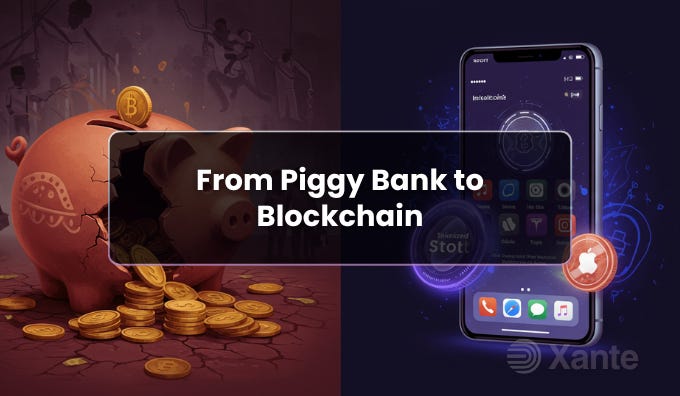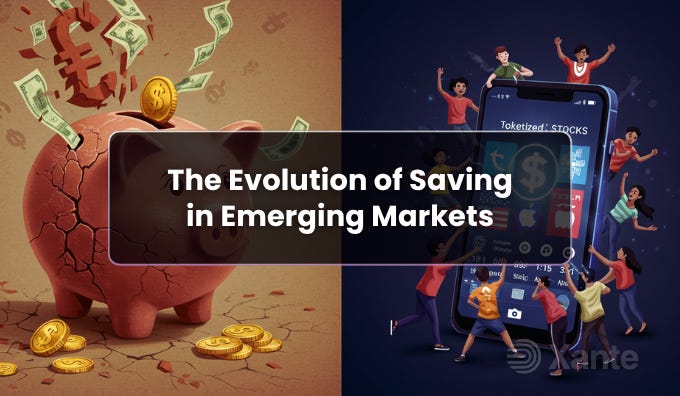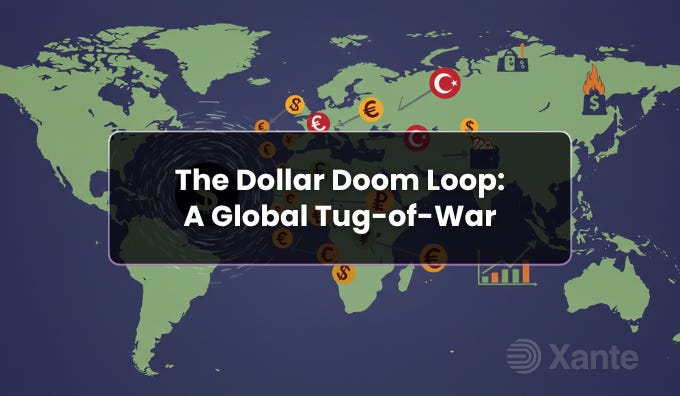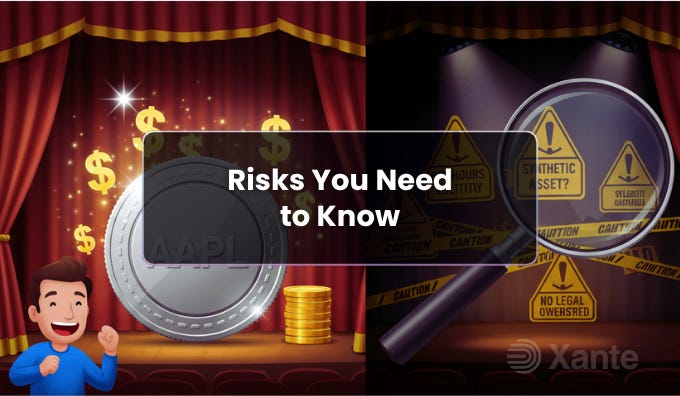Why Tokenized U.S. Stocks Are Becoming the New Savings Account in Emerging Markets
As inflation and currency crises rock emerging economies, a new financial trend is emerging: stablecoins for security, and tokenized equities for growth. Discover why blockchain-based U.S. stocks may be the next logical step for global investors locked out of Wall Street.
Why Tokenized U.S. Stocks Are Becoming the New Savings Account in Emerging Markets
From Stablecoins to Tokenized Equities, The Real Reason Emerging Economies Are Flocking to Blockchain Finance
Are You Living in a Financial System That’s Failing You?
If you live in a country where your currency loses value every month…
If you can’t easily open a U.S. brokerage account…
If moving money takes days and costs a small fortune…
Then this blog post is for you.
Today, we’ll explain why tokenized U.S. equities are emerging as the logical next step for users in emerging markets (EMs), not out of hype or speculation but out of pure economic necessity.
This isn’t about betting on crypto. It’s about protecting savings, generating returns, and bypassing broken financial systems.
We’ll explore:
What the “Dollar Doom Loop” means for you
How stablecoins became lifelines in countries like Bolivia and Nigeria
Why tokenized equities are not just for Wall Street insiders
How platforms like @xStocksFi are quietly creating access to the global equity markets
Real-world examples, adoption stats, and risks to consider
Let’s unpack this behavioral shift and what it means for your future finances.
Section 1: The Dollar Doom Loop And Why It Hits You Hardest
When the Fed sneezes, emerging markets catch pneumonia.
What is the Dollar Doom Loop?
It’s a global financial cycle where:
The U.S. Federal Reserve raises interest rates
Investors flock to dollar assets
The dollar strengthens
Emerging market currencies collapse
EM governments raise rates or burn reserves
Local economies suffer—and the cycle repeats
Real-World Example: Argentina & Turkey (2018–2022)
When the Fed tightened in 2018, Argentina’s peso and Turkey’s lira tanked. By 2022, the same happened again, triggering capital flight and surging local interest rates. People couldn’t trust their savings accounts or their governments.
In these moments, the U.S. dollar becomes more than just a currency. It becomes a lifeboat.
Section 2: Stablecoins: The Digital Dollar for the Forgotten Billions
Stablecoins like USDT and USDC are dollar-pegged cryptocurrencies that run on blockchain rails.
They’ve become:
A store of value in countries with high inflation
A medium of exchange where banks are slow or corrupt
An escape hatch from capital controls
Bolivia Case Study:
In Jan 2024, crypto volume was modest.
By mid-2025, it had increased 5x.
Inflation soared, regulations eased, and people turned to stablecoins not because they wanted to speculate but because they had no other option.
Other EMs like Nigeria and Turkey show similar patterns.
Behavior Shift:
These users aren’t degens.
They’re not chasing “moonshots.”
They’re preserving purchasing power in a system that’s stacked against them.
Section 3: The Next Step: Tokenized Equities for Real Returns
Stablecoins protect your money from devaluation.
But they don’t grow your wealth.
If you’re holding dollars long-term, you’re still losing purchasing power, just at a slower rate.
Enter: Tokenized U.S. equities.
These are blockchain-based versions of stocks like Apple, Tesla, or Microsoft accessible from your wallet, 24/7.
Why They Matter:
Dollar-linked + yield-generating
No need for a U.S. bank account
No brokerage hoops, no capital control traps
Powered by crypto rails, but tied to real-world assets
Real-Life Example: Egypt
Inflation routinely hits 20–30% annually. Even holding U.S. dollars only slows the bleeding.
Tokenized equities offer exposure to U.S. corporate growth and a way for families to beat inflation without needing full crypto exposure.
Section 4: xStocksFi: The Quiet Revolution
Launched recently, @xStocksFi allows anyone to trade tokenized U.S. equities on public blockchains.
Key Stats:
$37.8 million in total trading volume
Over 1,500% growth in token-holding addresses
$8.56 million in daily trading volume on July 3
Activity spans Asia, Latin America, and Europe
This platform isn’t trying to “kill Wall Street.”
It’s offering a lifeline to people locked out of traditional markets.
Just like stablecoins started slow and then exploded in use, tokenized equities are following the same arc.
Section 5: Risks You Need to Know
This isn’t a silver bullet. There are real limitations:
Synthetic Tokens: Not all are backed 1:1 by real stocks some just track price without ownership.
Off-Hours Volatility: Tokens trade 24/7, but U.S. markets don’t. This can lead to price dislocations.
Retail Hype Risk: Without proper education, some users may buy into assets they don’t fully understand.
Unhedgeable gaps can punish uninformed traders, notes analyst Rob Hadick.
Always do your homework and choose platforms with transparency.
Key Takeaways
Emerging markets are ground zero for real-world crypto adoption.
Stablecoins aren’t just for trading they’re for surviving inflation.
Tokenized equities build on this behavior, offering dollar-based returns with blockchain accessibility.
Platforms like xStocksFi show early, credible signs of traction.
Risks exist, especially around transparency, custody, and liquidity gaps.
Future Outlook: What’s Next for Tokenized Equities?
✅ As global inflation persists, the demand for return-yielding, dollar-linked assets will grow.
✅ As more EM governments relax crypto restrictions, adoption will accelerate.
✅ As regulators like SEC Commissioner Hester Peirce call for modernization, legal clarity will improve.
✅ As wallet UX and education improve, more non-technical users will join.
Shortly, buying a U.S. stock from Cairo or Caracas could be as easy as sending a WhatsApp message.
Actionable Suggestions
For Users in EMs:
Start with reputable stablecoins (USDC, USDT)
Research platforms offering regulated tokenized equities
Avoid synthetic-only assets without clear disclosures
Dollar-cost averaging into equities avoids trying to time the market
For Builders:
Prioritize mobile UX and fiat on-ramps
Partner with local wallets and stablecoin providers
Educate users, especially about risk
For Policymakers:
Regulate access, don’t ban it
Encourage licensed platforms over gray markets
Support USD liquidity tools to prevent black-market reliance
Conclusion: The Real Revolution Isn’t Crypto, It’s Access
Stablecoins saved people’s savings. Tokenized equities may grow them.
This trend isn’t about flipping NFTs or trading meme coins. It’s about economic survival in the most unequal parts of the global financial system.
When local money fails, people improvise. When formal systems exclude them, they find alternatives.
And that’s the real promise of Web3: access, not speculation.
Start exploring regulated platforms that offer tokenized equities.
Learn how blockchain can give you access to real, dollar-based opportunities even if your bank or country won’t.
Got questions about stablecoins or tokenized stocks? Drop them in the comments. Let’s build financial resilience, together.
Subscribe to our newsletter for expert analysis and join our WhatsApp channel to continue the conversation. For daily updates, follow us on all socials; Instagram, Twitter, Telegram, and TikTok.
This article is for educational purposes only and should not be considered financial advice. Always conduct your own research (DYOR) before making any investment decisions.





